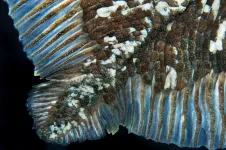Coelacanths may live nearly a century, five times longer than researchers expected
2021-06-17
(Press-News.org) Once thought to be extinct, lobe-finned coelacanths are enormous fish that live deep in the ocean. Now, researchers reporting in the journal Current Biology on June 17 have evidence that, in addition to their impressive size, coelacanths also can live for an impressively long time--perhaps nearly a century.
The researchers found that their oldest specimen was 84 years old. They also report that coelacanths live life extremely slowly in other ways, reaching maturity around the age of 55 and gestating their offspring for five years.
"Our most important finding is that the coelacanth's age was underestimated by a factor of five," says Kélig Mahé of IFREMER Channel and North Sea Fisheries Research Unit in Boulogne-sur-mer, France. "Our new age estimation allowed us to re-appraise the coelacanth's body growth, which happens to be one of the slowest among marine fish of similar size, as well as other life-history traits, showing that the coelacanth's life history is actually one of the slowest of all fish."
Earlier studies attempted to age coelacanths by directly observing growth rings on the scales of a small sample of 12 specimens. Those studies led to the notion that the fish didn't live more than 20 years. If that were the case, it would make coelacanths among the fastest-growing fish given their large size. That seemed surprising considering that the coelacanth's other known biological and ecological features, including slow metabolism and low fecundity, were more typical of fish with slow life histories and slow growth like most other deep-water species.
In the new study, Mahé, along with co-authors Bruno Ernande and Marc Herbin, took advantage of the fact that the French National Museum of Natural History (Muséum National d'Histoire Naturelle de Paris, MNHN) has one of the largest collections of coelacanths in the world, ranging from embryos in utero to individuals of almost two meters. They were able to examine 27 specimens in all. They also used new methods, including polarized light microscopy and scale interpretation technology mastered at IFREMER's Sclerochronology Centre, Boulogne-sur-mer, France, to estimate individuals' age and body growth more precisely than before.
While earlier studies relied on more readily visible calcified structures called macro-circuli to age the coelacanths much as counting growth rings can age a tree, the new approaches allowed the researchers to pick up on much tinier and nearly imperceptible circuli on the scales. Their findings suggest that the coelacanths actually are about five times older than was previously thought.
"We demonstrated that these circuli were actually annual growth marks, whereas the previously observed macro-circuli were not," Mahé says. "It meant that the maximum longevity of coelacanth was five times longer than previously thought, hence around a century."
Their study of two embryos showed they were both about five years old. Using a growth model to back-calculate gestation length based on the size of offspring at birth, the researchers got the same answer. They now think that coelacanth offspring grow and develop for five years inside their mothers prior to birth.
"Coelacanth appears to have one of, if not the slowest life histories among marine fish, and close to those of deep-sea sharks and roughies," Mahé says.
The researchers say that their findings have implications for the coelacanth's conservation and future. They note that the African coelacanth is assessed as critically endangered in the Red List of Threatened Species of IUCN.
"Long-lived species characterized by slow life history and relatively low fecundity are known to be extremely vulnerable to perturbations of a natural or anthropic nature due to their very low replacement rate," Mahé says. "Our results thus suggest that it may be even more threatened than expected due to its peculiar life history. Consequently, these new pieces of information on coelacanths' biology and life history are essential to the conservation and management of this species."
In future studies, they plan to perform microchemistry analyses on coelacanth scales to find out whether a coelacanth's growth is related to temperature. The answer will provide some insight into the effects of global warming on this vulnerable species.
INFORMATION:
Current Biology, Mahé et al.: "New scale analyses reveal centenarian coelacanths Latimeria chalumnae" https://www.cell.com/current-biology/fulltext/S0960-9822(21)00752-1
Current Biology (@CurrentBiology), published by Cell Press, is a bimonthly journal that features papers across all areas of biology. Current Biology strives to foster communication across fields of biology, both by publishing important findings of general interest and through highly accessible front matter for non-specialists. Visit http://www.cell.com/current-biology. To receive Cell Press media alerts, contact press@cell.com.
[Attachments] See images for this press release:

ELSE PRESS RELEASES FROM THIS DATE:
2021-06-17
The birth of a human being requires billions of cell divisions to go from a fertilised egg to a baby. At each of these divisions, the genetic material of the mother cell duplicates itself to be equally distributed between the two new cells. In primary microcephaly, a rare but serious genetic disease, the ballet of cell division is dysregulated, preventing proper brain development. Scientists from the University of Geneva (UNIGE), in collaboration with Chinese scientists, have demonstrated how the mutation of a single protein, WDR62, prevents the proper formation of the cable network responsible for separating genetic material into two. As cell division is then slowed down, the brain ...
2021-06-17
BOSTON - An antibiotic developed in the 1950s and largely supplanted by newer drugs, effectively targets and kills cancer cells with a common genetic defect, laboratory research by Dana-Farber Cancer Institute scientists shows. The findings have spurred investigators to open a clinical trial of the drug, novobiocin, for patients whose tumors carry the abnormality.
In a study in the journal Nature Cancer, the researchers found that in laboratory cell lines and tumor models novobiocin selectively killed tumor cells with abnormal BRCA1 or BRCA2 genes, which help repair damaged DNA. The drug was effective even in tumors resistant to agents known as PARP inhibitors, which have become a prime therapy for cancers with DNA-repair glitches.
"PARP inhibitors ...
2021-06-17
Ultrathin, flexible computer circuits have been an engineering goal for years, but technical hurdles have prevented the degree of miniaturization necessary to achieve high performance. Now, researchers at Stanford University have invented a manufacturing technique that yields flexible, atomically thin transistors less than 100 nanometers in length - several times smaller than previously possible. The technique is detailed in a paper published June 17 in Nature Electronics.
With the advance, said the researchers, so-called "flextronics" move closer to reality. Flexible electronics promise bendable, ...
2021-06-17
PHILADELPHIA-- The COVID-19 death rate for Black patients would be 10 percent lower if they had access to the same hospitals as white patients, a new study shows. Researchers from the Perelman School of Medicine at the University of Pennsylvania and OptumLabs, part of UnitedHealth Group, analyzed data from tens of thousands of hospitalized COVID-19 patients and found that Black patients died at higher rates than white patients. But the study, published today in JAMA Network Open, determined that didn't have to be the case if more Black patients were able to get care at different hospitals.
"Our study reveals that Black patients have worse outcomes largely because they tend to go to worse-performing hospitals," said the study's first author, David Asch, MD, ...
2021-06-17
What The Study Did: The findings of this study suggest that the increased mortality among Black patients hospitalized with COVID-19 is associated with the hospitals at which Black patients disproportionately received care.
Authors: David A. Asch, M.D., M.B.A., of the University of Pennsylvania in Philadelphia, is the the corresponding author.
To access the embargoed study: Visit our For The Media website at this link https://media.jamanetwork.com/
(doi:10.1001/jamanetworkopen.2021.12842)
Editor's Note: Please see the article for additional information, including other authors, author contributions and affiliations, conflict of interest and financial disclosures, ...
2021-06-17
What The Study Did: Researchers evaluated the association of convalescent plasma treatment with 30-day mortality in hospitalized adults with hematologic (blood) cancers and COVID-19.
Authors: Jeremy L.Warner, M.D., M.S., of Vanderbilt University in Nashville, Tennessee, is the corresponding author.
To access the embargoed study: Visit our For The Media website at this link https://media.jamanetwork.com/
(doi:10.1001/jamaoncol.2021.1799)
Editor's Note: The article includes conflict of interest and funding/support disclosures. Please ...
2021-06-17
What The Study Did: This study examined whether mandatory daily employee symptom data collection can be used as an early alert surveillance system to estimate COVID-19 hospitalizations in communities where employees live.
Authors: Steven Horng, M.D., M.MSc., of Beth Israel Deaconess Medical Center in Boston, is the the corresponding author.
To access the embargoed study: Visit our For The Media website at this link https://media.jamanetwork.com/
(doi:10.1001/jamanetworkopen.2021.13782)
Editor's Note: Please see the article for additional information, including other authors, author contributions and affiliations, conflict of interest and financial disclosures, and funding and support.
INFORMATION:
Media advisory: The full study ...
2021-06-17
What The Study Did: In this survey study, COVID-19 was associated with large reductions in economic security among women at high risk of HIV infection in Kenya. However, shifts in sexual behavior may have temporarily decreased their risk of HIV infection.
Authors: Harsha Thirumurthy, Ph.D., of the Perelman School of Medicine at the University of Pennsylvania in Philadelphia, is the the corresponding author.
To access the embargoed study: Visit our For The Media website at this link https://media.jamanetwork.com/
(doi:10.1001/jamanetworkopen.2021.13787)
Editor's Note: The article includes funding/support disclosures. Please see the article for additional information, including other authors, ...
2021-06-17
What The Study Did: Researchers estimated survival and other outcomes of very preterm infants in China discharged against medical advice from neonatal intensive care units before complete care can be provided compared with infants who receive full intensive care treatment.
Authors: Yun Cao, M.D., Ph.D., and Weili Yan, Ph.D., of Children's Hospital of Fudan University in Shanghai, China, are the corresponding authors.
To access the embargoed study: Visit our For The Media website at this link https://media.jamanetwork.com/
(doi:10.1001/jamanetworkopen.2021.13197)
Editor's Note: The article includes conflicts of interest and funding/support disclosures. Please see the article for additional information, including other authors, author contributions and affiliations, conflict of interest ...
2021-06-17
The 'Xpert Ultra' molecular test has a greater capacity than its predecessor ('Xpert MTB/RIF') in detecting tuberculosis cases, either passively (i.e. people who attend the hospital with disease symptoms) or actively (searching for possible cases in the community among contacts of cases). This is the main conclusion of a study performed by ISGlobal, an institution supported by "la Caixa" Foundation, in collaboration with the Manhiça Health Research Centre (CISM), published in the European Respiratory Journal.
Tuberculosis (TB) is the leading cause of death by an infectious agent, worldwide. In 2019, 1.4 million people are estimated to have died and 10 million people fell sick from TB, although only 70% of the cases were diagnosed. ...
LAST 30 PRESS RELEASES:
[Press-News.org] Coelacanths may live nearly a century, five times longer than researchers expected

